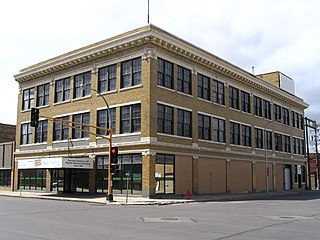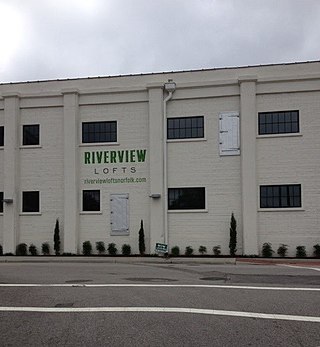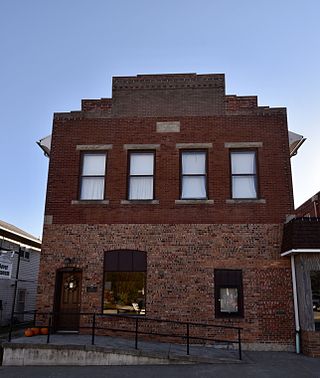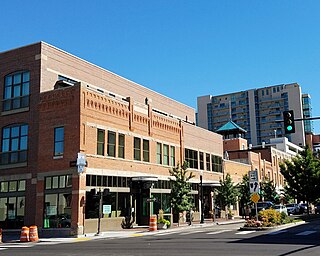
Fargo Station is a train station in Fargo, North Dakota, United States. It is served by Amtrak's Empire Builder. It is the only railway station in use in the Fargo-Moorhead area and is the third-busiest in North Dakota. The platform, tracks, and station are currently all owned by BNSF Railway. The station is currently located in the former BNSF freight house. The former main station building is now home to Great Northern Bicycle Co.

The Omaha Rail and Commerce Historic District, roughly bounded by Jackson, 15th, and 8th Streets, as well as the Union Pacific main line, is located in downtown Omaha, Nebraska. Today this historic district includes several buildings listed individually on the National Register of Historic Places, including the Union Pacific Depot and the Burlington Station.

This is a list of the National Register of Historic Places listings in Clay County, Minnesota. It is intended to be a complete list of the properties and districts on the National Register of Historic Places in Clay County, Minnesota, United States. The locations of National Register properties and districts for which the latitude and longitude coordinates are included below, may be seen in an online map.

The Commercial Historic District in Potlatch, Idaho was listed on the National Register of Historic Places in 1986. In 1986, it included seven contributing buildings and a contributing object. It includes work by architect C. Ferris White and work by A.M. Homes.

Fargo City Detention Hospital is a building in Fargo, North Dakota, United States, that was built in 1910. The hospital was designed as a place to sequester people afflicted with contagious disease.

William F. Kurke (1889–1965) was a prolific architect in North Dakota.

The Pence Automobile Company Warehouse, also known as Richtman's Printing, is a historic commercial building located on Northern Pacific Avenue in Fargo, North Dakota. It was designed in 1918 by Minneapolis architects Long, Lamoreaux & Long in Classical Revival architecture. The building was completed in 1920 at a cost of more than $175,000. It was listed on the National Register of Historic Places in 1994.

The Minden Wool Warehouse is a historic building at 1615 Railroad Avenue in Minden, Nevada. Built in 1915, it was designed by prominent Nevada architect Frederic Joseph DeLongchamps for Minden founder H. F. Dangberg, as the headquarters of the Dangberg Land and Livestock Company. Carson Valley farmers stored wool and potatoes there to be shipped out of Minden. It was later rented to the Minden Flour Company and a local creamery. It is now an office building for the Bently Nevada Corporation.

Virginia Ice & Freezing Corporation Cold Storage Warehouse is a historic cold-storage warehouse building in Norfolk, Virginia, United States. It was built in 1920, and is a three-story concrete block building on a concrete foundation, built in three sections. The sections are a two-story, eight-bay warehouse; a three-story, L-shaped addition; and a two-story concrete block addition. The Virginia Ice & Freezing Corp. had one of the largest ice and cold storage operations in Norfolk and was next to several of the leading oyster and fish processing plants.

The Bellows Falls Co-operative Creamery Complex is a historic industrial property in Bellows Falls, Vermont. Developed over a period of about 40 years beginning c. 1906, the complex, with two surviving buildings, it represents one of Vermont's largest commercial enterprises of the period. The property, located on the eastern side of Bellows Falls Island, was listed on the National Register of Historic Places in 1990.

The Agen Warehouse, also known as the 1201 Western Building is an historic former warehouse building located at 1201 Western Avenue in Seattle, Washington. Originally constructed in 1910 by John B. Agen (1856–1920), widely considered the father of the dairy industry in the Northwest, for his wholesale dairy commission business, it was designed by the partnership of John Graham, Sr. and David J. Myers with later additions designed by Graham alone. After years of industrial use, the building was fully restored to its present appearance in 1986 for offices and retail with the addition of a penthouse and was added to the National Register of Historic Places on January 23, 1998.

The Portland Thirteenth Avenue Historic District is a 11.7-acre (4.7 ha) historic district which was listed on the National Register of Historic Places in 1987.
Springfield Warehouse and Industrial Historic District is a national historic district located in Springfield, Missouri, United States. It encompasses 16 contributing buildings and 1 contributing structure in a commercial / industrial section of Springfield. Developed between about 1891 and 1948, the district also includes representative examples of Italianate and Romanesque Revival style architecture. Notable buildings include the Springfield Ice and Refrigerator Company, Armour Creamery Boiler House, Andrew Rebori Company, Crighton Provision Company, and Armour Creamery Cold Storage Warehouse.

The Peterson Manufacturing Building, also known as the New London Cooperative Creamery, is a historic building located in New London, Iowa, United States. The first floor of this building was constructed in 1908 by John Edgar Peterson so he could expand his glove and mitten factory. Peterson was also instrumental in the establishing the First National Bank in New London and served as its president, the Henry County Telephone Company, the New London Improvement Company, and the New London Land Company. The second floor of this building was completed in 1909 by the local Masonic lodge. Peterson died in 1917 and glove and mitten factory closed briefly before it was reopened by the Fairfield Glove and Mitten Factory. In 1928 that factory closed and the building housed a creamery until 1968. After being used as a warehouse it was donated to the Dover Historical Society for a historical museum. The building was listed on the National Register of Historic Places in 1997.

The Armour & Co. Building is a historic building in San Francisco, California, United States, built for Armour and Company in 1907. It was listed on the U.S. National Register of Historic Places on December 22, 2009.
The Armour Creameries Poultry House, also known as the Armour warehouse and the Garst Company warehouse, is a historic building located in Coon Rapids, Iowa, United States. Jens Jensen sold his regional creamery business to Armour and Company in June 1928. That facility, which is no longer extant, was located on the north side of the central business district. By August, Armour was constructing a new building along the Chicago, Milwaukee, St. Paul and Pacific Railroad tracks on the south side of business district. By doing so Armour connected Coon Rapids with larger markets by upgrading one of its industries, bringing in outside professionals to operate it, bringing new workers to expand the town, and sending its products out to the larger markets. Armour continued operating this facility into the late 1950s. The building was bought by the Garst Seed Company, who used it as a warehouse. The building was listed on the National Register of Historic Places in 2011.
Gove & Walsh was an architectural firm based in Denver, Colorado which operated from 1896 to 1918. Aaron M. Gove and Thomas F. Walsh were partners. A number of its works are listed on the National Register of Historic Places.

The South Eighth Street Historic District in Boise, Idaho, is an area of approximately 8 acres (3.2 ha) that includes 22 commercial buildings generally constructed between 1902 and 1915. The buildings are of brick, many with stone cornices and rounded arches, and are between one and four stories in height. The area had been Boise's warehouse district, and many of the buildings were constructed adjacent to railroad tracks that separated downtown from its industrial core. The district is bounded by Broad and Fulton Streets and 8th and 9th Streets.

The Produce Terminal Cold Storage Company Building is a historic refrigerated warehouse at 1550 South Blue Island Avenue in the Near West Side neighborhood of Chicago, Illinois. Built in 1928–29, the warehouse was the largest cold storage facility in Chicago when it opened. As Chicago was a major shipping and transportation hub, refrigerated storage played a key role in preserving perishable goods so they could be sold year-round. Architects H. Peter Henschien, a renowned designer of refrigerated facilities, and Robert J. McLaren designed the Art Deco building. The top two stories of the eleven-story building feature extensive terra cotta and tile ornamentation, including chevrons, Egyptian-inspired colonettes, and a dentillated cornice with cymatium molding. In addition to its extensive refrigerated space, the interior plan also included processing and office space, improving efficiency and lowering costs for the building's tenants.

Rapid City Fruit Company is a historic building at 320 7th Street in Rapid City, South Dakota. It was listed on the National Register of Historic Places in 1993.




















